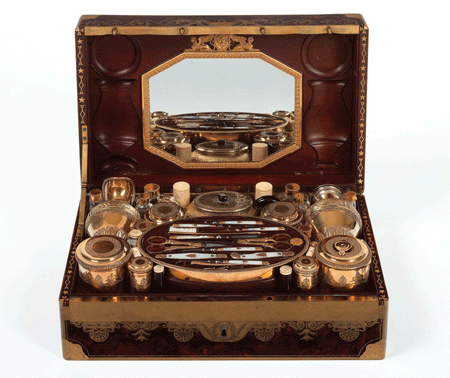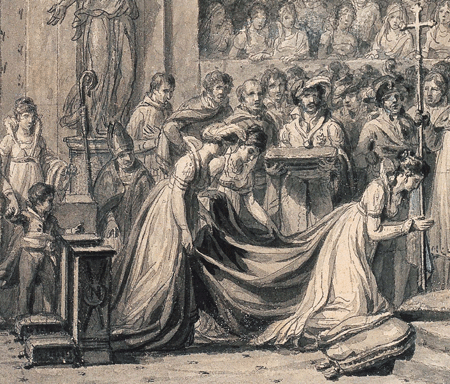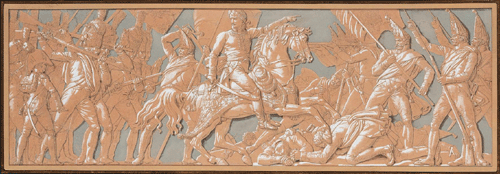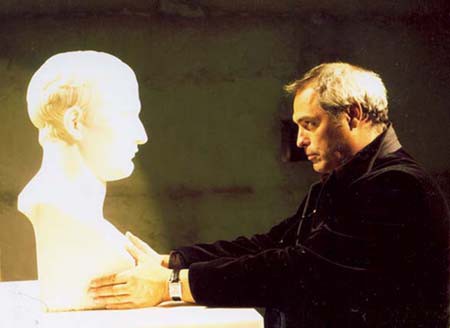Michel Albertini, author, theatre director, actor and scenographer, is a man of many parts
Born in the south of France, he first worked with Roland Petit and Zizi Jeanmaire who took him around the world with their ballet. He then studied theatre at the Conservatoire National de Paris, and as « Villa Médicis » scholar, he spent some time in New York. His meeting there with two authors, William Burroughs and Brion Gysin, was a fundamental moment in his career. On Broadway, he also participated in the first performance of « 36 Popular Front », a musical by Etienne Roda Gil.
In Europe, he appeared in several films and television series, co-starring with Sophia Loren, Sophie Marceau, Alain Delon, and Melanie Griffith, to mention but the best known…
Caption :
In Berlin, he played the role of « Das Lederman », « The Leather Man », directed by R.W. Fassbinder ; in Venice he was in « Le Martyre de Saint Sébastien » by d'Annunzio and Debussy, directed by Pier Luiggi Pizzi at the Fenice Theatre; and in Montréal, he acted in several popular television series.
Michel Albertini has written several plays which have been performed in various different Parisian theatres, most notably « Les Merdicoles », performed at the prestigious Comédie Française. He is also an author of a dozen French ‘Mills and Boon' novels, with titles like « Les Orphelins de Nha Trang », « Les amants du Séisme », and «L'amour a deux visages »…, produced by various publishers.
In Brazil, he is renowned as once of Europe's best and most talented scenographers. He here invites us on a journey of discovery into the intimacy of the court of Napoleon I.
The Treasures of the Fondation Napoléon”, an intimate view of the imperial court…
Walk down the Boulevard Haussmann, towards the Arc de Triomphe. Go past 148. That's the « Fondation Napoléon »: haunt of enthusiasts and scholars alike, men and women who labour to bring Napoleonic history and history of art to the world.
Go a little further down the road, and there you'll find 158, the Musée Jacquemart-André. Go up one floor. If you pass Bonaparte on the landing don't be surprised. He's just stepped in from Egypt. Further up, there‘s a second statue, this time in his later manifestation as legislator.
Go further…
 When you stand in the entrance to the first room, pause for a moment. Let your eyes get used to the shadow, so that they're ready to go into the light. For here you are going to begin one of the rarest and most remarkable visits possible in the autumn of 2004 and early winter of 2005.
When you stand in the entrance to the first room, pause for a moment. Let your eyes get used to the shadow, so that they're ready to go into the light. For here you are going to begin one of the rarest and most remarkable visits possible in the autumn of 2004 and early winter of 2005.
From the centre of the gloom two beams pick out a goblet and its case, a clock, some golden snuffboxes and portraits of some of the most beautiful women of the time. The watches below them stopped, amazed at their beauty. Look…
Light now pours in golden rays down upon these remnants of imperial society: porcelain, miniatures, paintings, furniture…. The journey has begun.
Now you can hear distant some music, coming from behind the windows. As you walk towards them you begin to see Paris before you.
The patterns on the silk hangings were composed in Lyons. Napoleon loved these drapes, and the empire saw the apogee of this art.
 Next comes the « Coronation » room. A Sèvres vase marks the entrance. Fontaine's watercolours seem to leap out at you the colours are so bright… That painting…? It's a David. The great painter. That dress? It was actually present at the coronation two hundred years ago… And through the windows you can see a procession. Don't ask questions. Follow the carriage. There are more treasures in store.
Next comes the « Coronation » room. A Sèvres vase marks the entrance. Fontaine's watercolours seem to leap out at you the colours are so bright… That painting…? It's a David. The great painter. That dress? It was actually present at the coronation two hundred years ago… And through the windows you can see a procession. Don't ask questions. Follow the carriage. There are more treasures in store.
Slip into the next, crypt-like room. You find yourself face to face with servants' bells, knives and forks, the chamberlain's keys, chairs. They were all used, all touched by him.
The following passageway gives onto an even more surprising, intimate room. A few notes on the harp tell you it's Josephine's. And there are flowers too, the and perfume of the Empire. The empress ‘Egyptian service' is there in an antique display case. The porcelain is of an extreme finesse. The park at Malmaison is filled with her, her husband, her love. You can see her, far in the distance, there by the bay… Don't disturb her. There are many other women in the room… Caroline, Elisa… Look, Hortense has forgotten her sewing things. Marie-Louise has left a portrait of the boy, Napoleon's son.
 Yet further still is the extraordinarily sumptuous “Headquarters' Service”. Nineteen plates. Each one of them is a masterpiece: «The Isthmus of Suez, the Obelisk of Mount Geneva, a regatta in Venice, the Orangerie of the Jardin des Plantes, the Pont du Jourdain, the Palais des Tuileries, the Abbey at Melk, the lighthouse at Alexandria… ». They have been brought together over the years by the Fondation Napoléon. But Napoleon is long gone. The drums, the campaigns in distant lands, he is waiting behind another door, in the madness of war, the arms, the standards and the armour …
Yet further still is the extraordinarily sumptuous “Headquarters' Service”. Nineteen plates. Each one of them is a masterpiece: «The Isthmus of Suez, the Obelisk of Mount Geneva, a regatta in Venice, the Orangerie of the Jardin des Plantes, the Pont du Jourdain, the Palais des Tuileries, the Abbey at Melk, the lighthouse at Alexandria… ». They have been brought together over the years by the Fondation Napoléon. But Napoleon is long gone. The drums, the campaigns in distant lands, he is waiting behind another door, in the madness of war, the arms, the standards and the armour …
Follow his hand. It indicates his destiny.
Forget Waterloo, the Crossing of the Berezina, the Peninsular War. This walk is going elsewhere. He alone interests us. The man, close up and personal. The smell of snuff, leather, liquorice, the little objects he carried around with him… The perfumes of yesteryear are just as heady as music.
And then, the end. He thought he was protected by his star. He had studied the constellations in Egypt. Whole nights spent in front of his tent looking at the sky. He probably learned there that the Pharaohs believed that they became « stars » after their deaths; and so continued to guide their peoples.
He too, long after his death, continued to guide his people. Through his codes, the banking system, the high schools, the prefects, the Légion d'honneur, the roads and bridges, the theatre legislation…
And just like at the theatre, one night, one of those stars crossed the stage. It came and rested over the vessel, the « Belle Poule », and accompanied it all the way back to French soil.
It was this light which I tried to recreate on this journey, starlight. Yes, the treasure is right here, marked by a star… Here, just below the heavens, right in front of you, here is the treasure of the Fondation Napoléon.
Michel Albertini, July 2004
Career
Scenographies
The Treasures of the Fondation Napoléon, Musée Jacquemart-André
Napoleao, Sao Paulo. FAAP.
Les Merdicoles, Comédie Française
Rodin, Théâtre de Neuilly.
Les rues sont vides, Centre Pompidou
Aïn Salah, Théâtre National
Dom Juan, Théâtre du Conservatoire
Theatre
– Acting
1993, Le martyre de Saint Sébastien, D'Annunzio-Debussy, Pier Luiggi Pizzi
1983, L'ambassade, Mrozec. Laurent Terzieff
1982, Caligula, Albert Camus. Patrick Guinand
1981, Les derniers mots de Dutch Schultz, William Burroughs. André Ligeonnet
1979, L'homme de cuir – H. Eppendorfer. P. Chatel – D. Schmidt – R. W. Fassbinder
1976, La guerre de Troie n'aura pas lieu, Jean Giraudoux. Jean Mercure
– Direction
1999, Les merdicoles – Comédie Française
1994, Dès le printemps, la cafétéria est ouverte dans le parc – Théatre Athlétic
1981, Aïn Salah – Jeune Théâtre National
Cinema
– Acting
1994, Nelly et Monsieur Arnaud by Claude Sautet
1991, Le trésor des îles chiennes by F.J. Ossang
1990, Le vent de la Toussaint by Gilles Behat
1989, Bille en tête by Carlo Cotti
1987, L'homme voile by Maroun Bagdadi
1985, Sacs de noeuds by Josiane Balasko
1984, L'amour braque by Andrzej Zulawski
1983, La femme publique by Andrzej Zulawski
1979, I comme Icare by Henri Verneuil
1974, Verdict by André Cayatte
Writing
– Theatre
2001, Cageot d'asperges
1999, Les merdicoles
1995, La séparation des amants sous la pluie
1994, Dès le printemps, la cafétéria est ouverte dans le parc
1993, Le chant du bouc
1989, Le babouin
1979, Aïn Salah
– Novels
2005, Sang d'Iguacu
2004, Les amants du séïsme
2004, L'amour au deux visages
2003, Les orphelins de Nha Trang
2002, L'espoir de Soledad
2001, L'enfant sale
1999, Le chemin des calanques
1998, Les merdicoles


